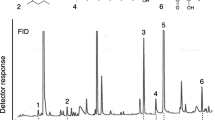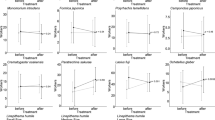Abstract
The caterpillars of Eutachytptera psidii (Lepidoptera: Lasiocampidae) mark trails between their nest and distant feeding sites with a trail pheromone secreted from the ventral surfaces of their last abdominal segments. The threshold sensitivity to artificial trails prepared from an hexane extract of the pheromone was 0.75 × 10−3 caterpillar-equivalents per cm of trail. In tests of trail-specificity involving four other social species, the caterpillars responded only to trails prepared from a pheromone extract of the closely related genus Gloveria. Tests were conducted to determine the efficiency with which colonies abandon exhausted feeding sites in favor of new food finds. On their first forays after their food sources were experimentally moved from established feeding sites to new sites, 67.5 ± 3.6% of all the evening’s activity occurred on pathways leading to the previously established sites. During their next two forays, 86.3 ± 3.7% and 92.1 ± 2.0% of all activity occurred on pathways leading to the new sites. Efficient abandonment of exhausted feeding sites is attributed to the persistence of the trail pheromone, differential marking of new and old pathways and to the caterpillar’s ability to discern trail strength and to choose stronger over weaker trails at choice points.



Similar content being viewed by others
References
Costa JT, Fitzgerald TD, Janzen DH (2004) Trail-following and natural history of the social caterpillar of Arsenura armida in Costa Rica (Lepidoptera: Saturniidae: Arsenurinae). Tropical Lepidoptera 12:17–23
Crump D, Silverstein RM, Williams HJ, Fitzgerald TD (1987) Identification of the trail pheromone of the eastern tent caterpillar Malacosoma americanum (Lepidoptera: Lasiocampidae). J Chem Ecol 13:397–402
Estebanes-Gonzáles ML (1964) Biología de Eutachyptera psidii (Sallé) en las regiones de Necaxa, Puebla y Zacualtipán, Hidalgo. Boletin Técnico del Instituto Nacional de Investigaciones Forestales, 16 pp
Fitzgerald TD (1993) Trail following and recruitment: response of eastern tent caterpillar Malacosoma americanum to 5β-cholestane-3-24-dione and 5-cholestan-3-one. J Chem Ecol 19:449–457
Fitzgerald TD (1995) The tent caterpillars. Cornell University Press, Ithaca
Fitzgerald TD (2003) The role of a trail pheromone in the foraging and processionary behavior of Thaumetopoea pityocampa. J Chem Ecol 12:513–532
Fitzgerald TD, Costa JT (1986) Trail-based communication and foraging behavior of young colonies of the forest tent caterpillar Malacosoma disstria Hubn. (Lepidoptera: Lasiocampidae). Ann Entomol Soc Am 79:999–1007
Fitzgerald TD, Pescador-Rubio A (2002) Trail marking, trail following and source of the trail pheromone of the processionary caterpillar Hylesia lineata Druce (Lepidoptera: Saturniidae). J Insect Behav 15:659–674
Fitzgerald TD, Peterson SC (1983) Elective recruitment communication by the eastern tent caterpillar (Malacosoma americanum). Anim Behav 31:417–442
Fitzgerald TD, Underwood DLA (1998a) Communal foraging behavior and recruitment communication in Gloveria sp. (Lepidoptera: Lasiocampidae). J Chem Ecol 24:1381–1396
Fitzgerald TD, Underwood DLA (1998b) Trail marking by the larva of the madrone butterfly Eucheira socialis and the role of the trail pheromone in communal foraging behavior. J Insect Behav 11:247–263
Fitzgerald TD, Webster FX (1993) Identification and behavioral assays of the trail pheromone of the forest tent caterpillar Malacosoma disstria Hubner (Lepidoptera: Lasiocampidae). Can J Zool 71:1511–1515
Fitzgerald TD, Pescador-Rubio A, Isaacs G (2008) Foraging behavior of the social caterpillar Eutachyptera psidii (Sallé) (Lepidoptera: Lasiocampidae) during a prolonged period of food and water deprivation. Ecol Entomol 33:727–734
Franclemont JG (1973) Mimallonoidea and Bombycoidea. In: Dominick RB et al (eds) The moths of America North of Mexico. Vol. 20.1. EW Classey & RBD Publications Ltd, London
Hernández-Bas F, Guevara-Garcia A (2000) Apuntes de entomologia forestal. I: el gusano de bolsa Eutachyptera psidii (Salle), Lepidoptera: Lasiocampidae) en el estado de Veracruz, México. Foresta Veracruzana, 2:51–58
Nashida K (2010) Description of the immature stages and life history of Euselasia (Lepidoptera: Riodinidae) on Miconia (Melastomataceae) in Costa Rica. Zootaxa 2466:1–74
Passoa S (1982) Eutachyptera psidii (Sallé) in Honduras (Lepidoptera: Lasiocampidae). Florida Entomol 65:379–381
Pescador-Rubio A, Stanford-Camargo SG, Páez-Gerardo LE, Ramírez-Reyes AJ, Ibarra-Jiménez RA, Fitzgerald TD (2011) Trail marking by larvae of the silverspot butterfly Dione juno huascuma. J Insect Sci Vol II: Article 55
Peterson SC (1988) Chemical trail marking and following by caterpillars of Malacosoma neustria. J Chem Ecol 14:815–823
Peterson SC, Fitzgerald TD (1991) Chemoorientation of eastern tent caterpillars to trail pheromone 5β-cholestane-3-24-dione. J Chem Ecol 17:1963–1972
Regier JC, Mitter C, Piegler RS, Friedlander TP (2000) Phylogenic relationships in Lasiocampidae (Lepidoptera): initial evidence from elongation factor-1α sequences. Insect Syst Evol 31:179–186
Roessingh P (1989) The trail following behaviour of Yponomeuta cagnagellus. Entomol Exp Appl 51:49–57
Roessingh P (1990) Chemical marker from silk of Yponomeuta cagnagellus. J Chem Ecol 16:2203–2216
Ruf C (2003) Social life-styles in caterpillars: behavioral mechanisms and ecological consequences. Ph.D thesis, University of Bayreuth, Bayreuth, Germany (http://opus.ub.uni-bayreuth.de/volltexte/2003/29/)
Ruf C, Fiedler K (2000) Trail following as a rare phenomenon among non-social lappet moth larvae (Lasiocampidae). Entomol Gener 25:17–25
Ruf C, Fiedler K (2002) Plasticity in foraging patterns of larval colonies of the small eggar moth, Eriogaster lanestris (Lepidoptera: Lasiocampidae). Oecologia 131:626–634
Ruf C, Costa JT, Fiedler K (2001) Trail-based communication in social caterpillars of Eriogaster lanestris (Lepidoptera: Lasiocampidae). J Insect Behav 14:231–245
Acknowledgements
Research supported by NSF (INT 0205841), CONACyT (J200.441), Fideicomiso ‘Ramón Alvarez-Buylla de Aldana’ projects: 75/01, 236/03 and 366/05 and SEP-CONACYT (2003-01-06-001-058). Caterpillars used for laboratory studies were maintained under APHIS permit 49345.
Author information
Authors and Affiliations
Corresponding author
Rights and permissions
About this article
Cite this article
Fitzgerald, T.D., Pescador-Rubio, A. Trail Marking and Abandonment of Depleted Feeding Sites by the Caterpillars of Eutachyptera psidii (Lepidoptera: Lasiocampidae). J Insect Behav 24, 380–392 (2011). https://doi.org/10.1007/s10905-011-9263-y
Revised:
Accepted:
Published:
Issue Date:
DOI: https://doi.org/10.1007/s10905-011-9263-y




